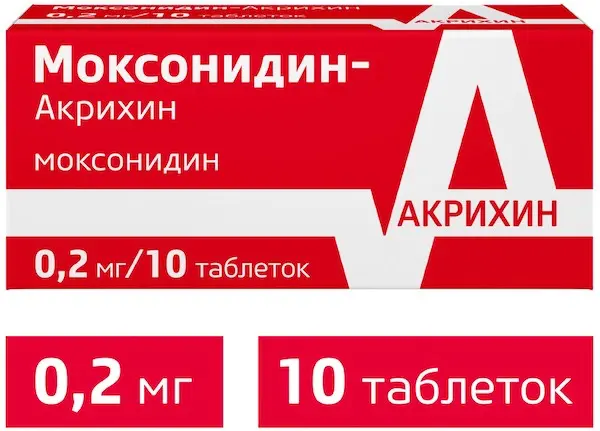Description
Moxonidine-Acrichine Pharmacodynamics
Moxonidine is a hypotensive agent with a central mechanism of action. In brain stem structures (rostral layer of lateral ventricles) moxonidine selectively stimulates imidazoline-sensitive receptors involved in tonic and reflex regulation of sympathetic nervous system. Stimulation of imidazoline receptors reduces peripheral sympathetic activity and blood pressure (BP).
Moxonidine differs from other sympatholytic hypotensive agents in its lower affinity for α2-adrenoreceptors, which explains the lower probability of developing sedative effects and dry mouth.
Administration of moxonidine results in reduction of systemic vascular resistance and BP. The hypotensive effect of moxonidine has been confirmed in double-blind placebo-controlled randomized trials. The results of a clinical trial involving 42 patients with arterial hypertension and left ventricular hypertrophy (LVH) demonstrated that with similar blood pressure reduction, the use of a combination of angiotensin II receptor antagonists with moxonidine reduces LVH to a greater extent compared to the free combination of thiazide diuretic and calcium channel blocker (15% versus 11%; p < 0.05).
Moxonidine improves insulin sensitivity index by 21% (compared with placebo) in patients with obesity, insulin resistance, and moderate arterial hypertension.
Indications
Arterial hypertension.
Contraindications .
– Hypersensitivity to the active substance or other components
drug;
– History of angioedema;
– Sinus node weakness syndrome or sinoatrial block;
– Severe bradycardia (resting heart rate (HR) less than 50 bpm);
– Grade II or III atrioventricular block;
– Acute and chronic heart failure;
– severe hepatic insufficiency;
– severe renal insufficiency (CKR less than 30 ml/min, plasma creatinine more than 160 μmol/l);
– lactase deficiency, lactose intolerance, glucose-galactose malabsorption;
– under 18 years of age (efficacy and safety have not been established);
– Breast-feeding period;
– concomitant use with tricyclic antidepressants.
Dosage and administration
- Orally, regardless of meals.
- In most cases, the initial dose of the drug Moxonidine is 0.2 mg per day. The maximum single dose is 0.4 mg.
- The maximum daily dose to be divided into 2 doses is 0.6 mg. Individual adjustment of the daily dose is necessary depending on patient’s tolerance to the therapy.
- No dose adjustment is required for patients with hepatic insufficiency. The initial dose for patients on hemodialysis is 0.2 mg per day. In case of necessity and good tolerability the daily dose may be increased up to maximum 0.4 mg per day.
- In patients with renal insufficiency, a cautious selection of the dose is recommended, especially at the beginning of treatment. The initial dose should be 0.2 mg per day. If necessary and in case of good tolerability, daily dose of this medicine can be increased up to maximum 0.4 mg for patients with moderate renal insufficiency (CKD more than 30 ml/min, but less than 60 ml/min) and 0.3 mg for patients with severe renal insufficiency (CKD less than 30 ml/min).





